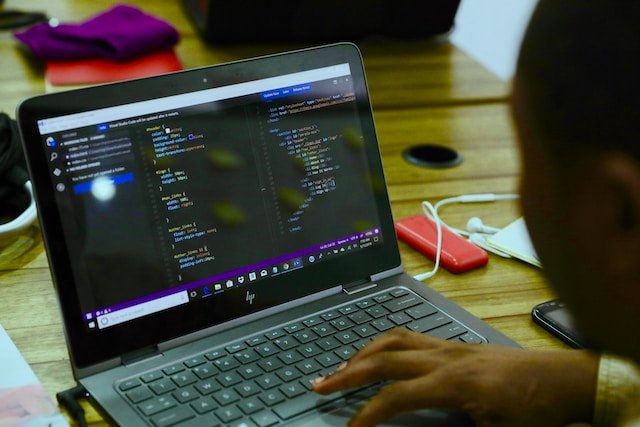Laptop Charging Port Is Loose?
A laptop’s charging port that is not working is a problem that can be frustrating. If the port is unstable, it can interfere with the connection to the charger, which can lead to intermittent charging or the charging being ineffective. The issue could be due to wear and tear as well as physical damages. A professional repair service is suggested to ensure a secure charge solution and to avoid any possibility of further problems.
How Can You Repair A Laptop’s Charger Port Broken

Before making any repairs, it’s essential to identify the issue correctly. A laptop charger port that is loose may be caused by a variety of causes, including manufacturing defects, physical damage even wear and tear that occurs over time. Here’s how to determine whether your laptop’s charger port is, in fact, loose
Physical Examination
Check the laptop’s charging port visually. If it shakes or moves in a way that is excessive while the charging device is in, It’s a clear sign of a weak connection. Make sure to be gentle while you examine it to avoid more injury.
Testing Different Chargers
Try using other chargers compatible with your laptop. If the issue is persistent across several chargers, it’s most likely an issue with the laptop’s charger port, not the charger itself.
Battery Charging Issues
Take note of any issues with charging. If your laptop is unable to charge on a regular basis or charges only in the event that the cable charging is placed in a particular location, it’s probably because of a loose charger port.
Causes of a Loose Laptop Charger Port
Finding the root of the issue is vital to find a solution. Here are a few of the most typical reasons for why your laptop’s charger port might get loose:
Frequent Plugging and Unplugging
In time, repeated removal and insertion of the charger may cause the port to become loose. ports internal components.
Physical Damage
Inaccidental impacts or drops can damage the port for charging, which can lead to instability and loose connection.
Manufacturing Defects
In certain instances, laptops might have defects in the manufacturing process of the design of their charger ports, which makes them more susceptible to loosening in time.
How To Fix A Loose Laptop Charger Port

After we’ve identified the problem as well as the possible sources, let’s look at the solution to fix the laptop’s charger port that is not working. Be aware that these fixes could invalidate your laptop’s warranty; therefore, do it at your own risk. If your laptop’s still under warranty, you should seek out repairs from the manufacturer.
Tightening the Port
If the port on your laptop’s charger is a little loose, it is possible to fix it by gently tightening the port. In order to do this, you’ll have to remove the laptop from the computer carefully and then access the port for charging. Make use of a small screwdriver to secure any loose connections or screws inside the port.
Reinforcing by Epoxy
If you are concerned about more serious damage, you can apply epoxy resin to strengthen the connections within the port for charging. Use a tiny amount of epoxy on the areas that are loose in accordance with the directions of the manufacturer. Be careful not to apply excessive amounts of epoxy, as it can do greater harm than it does good.
Replacing the Charger Port
If the laptop’s charger port is badly damaged or cannot be repaired with other methods, then it is recommended to replace the port completely. You can buy a replacement port for your charger online or at authorized repair centers for laptops. Make sure you check compatibility with your laptop model prior to purchasing.
Seek Professional Help
If you’re not sure of your technical expertise or uncertain about the problem, it’s recommended to consult an experienced tech who repairs laptops. They are knowledgeable and have the expertise to identify and fix the issue accurately without causing more damage.
My Laptop Isn’t Charging

The initial and most crucial step to take when confronted with computer charging problems is to confirm your power supply. Check that your charger is connected correctly to your laptop and your power source. Sometimes an issue with the connection may be the cause of the issue. Try connecting the charger to another outlet to eliminate any possible issues with or power source.
Examine the Charger and Cable
A defective charger or cable could be the cause of problems with charging. Examine the charger and cable for physical signs of damage, like bent or frayed wires. If you find any problems, you should consider replacing the cables with a compatible, high-quality charger that will provide an adequate power supply for your laptop.
Restart Your Laptop

It sounds simple it’s not, but an easy restart can solve numerous technical issues, including charging issues. Restart your laptop to see whether the issue with charging persists. Sometimes, the laptop’s software could encounter temporary issues, and a restart could clear them.
Update Device Drivers
Incorrect or outdated device drivers can cause problems with charging. To ensure your laptop functions smoothly, update your device drivers regularly. Visit the website of the manufacturer or utilize reliable driver update software to speed up the process.
Inspect the Battery
A damaged battery is one of the main reasons for laptops that don’t charge. Verify the health of your battery by checking the BIOS or settings of your laptop. If the health of your battery is seriously deteriorating, then you might need to replace it by purchasing a brand-new one. Many laptops have batteries that can be removed, and some have built-in batteries, which require professional assistance to replace them.
Reset the Battery Management System (BMS)
The process of resetting your Battery Management System can recalibrate the battery and fix problems with charging due to inaccurate power readings. To reset it, switch off your computer, unplug the charger, then press the power button for approximately 30 minutes. Connect the charger back and then restart your laptop to determine whether the issue continues.
Check for Software Conflicts
Sometimes, specific software applications may interfere with the computer’s charge procedure. Start your laptop in Safe Mode, which blocks any non-essential programs from running. If the problem with charging disappears when you are in Safe Mode, it indicates that a software conflict may be causing the problem. Locate and uninstall the recent software or run a system restore to fix the issue.
Verify the Charging Port
A malfunctioning charging port could stop your laptop from charging properly. Examine the port to check for physical damages or debris that could be blocking the connection. If you observe any issues you need assistance from a professional, fix or change the charger port.
Use Diagnostic Tools
Many laptop manufacturers offer diagnostic tools that can identify problems with the hardware. Use these tools to run thorough tests on your hardware and find any possible issues with your laptop’s charging circuitry or battery.
What Is The Reason My Charging Port Is Defective

- A vital component: The charging ports are the essential connectors that permit electricity to be transferred from your charger to the device’s battery. They play an essential function in maintaining our tablets, smartphones, and other devices powered up and ready to use.
- Complexity without complexity: While they may appear straightforward, charging ports appear to be simple, they’re actually intricate devices with many pins and circuits which require synchronization to allow an effective charging process to take place.
Common Causes of Charging Port Issues
- Physical damage: The primary reason for malfunctioning of the charging port can be physical damage. Drops, crashes, or even putting the charger in the wrong direction can cause damage to the pins of the port or even cause them to bend out of position.
- Dust and debris: The charging ports may accumulate dust, lint, or other particles in time, causing obstruction to an electrical link between chargers and devices. This blockage can affect the speed of charging and can cause a malfunctioning charging port.
- Moisture and exposure to liquids Liquid Exposure: Any exposure to liquids, whether it’s spilled water or high humidity, could cause corrosion to the internal components of the charging port. This corrosive process weakens the electrical contacts, which can cause charging problems.
- Wear and tear: Like any electronics component, the charging ports too get damaged over long-term usage. Continuous plugging and unplugging could result in port degrading and, eventually, cause charging issues.
Identifying Charging Port Problems
- Slow Charging: If you observe that your device is taking an extended time to charge, it could be the result of a malfunctioning charging port. A functioning charging port will rapidly charge your device in the time frame you expect.
- Intermittent Charging: Occasionally, the charging process could be intermittent, and the charger is connected and disconnected frequently. The reason for this is usually an issue with the charging port.
- No Charging Response: If the device doesn’t respond anyway when connected to the charger, then the charging port may be the reason.
- Burning Smell or Overheating: The smell of burning or overheated temperature in the vicinity of the charging port is a warning sign of the possibility of damage. In these situations, it is essential to fix the problem quickly to avoid any further issues.
Solutions and Precautions
- The cleaning of your Charging: Port easiest and most cost-effective solution for charging port problems is to regularly clean. Utilizing a non-metallic tool such as a toothpick or soft brush, get rid of any dust or dirt out of the port. Take care not to cause any further damage.
- Avoiding Liquid Exposure: Avoid contact with liquids on your device in any way you can. Keep your phone clear of water sources, and use waterproof covers to protect it from accidental spills.
- Use high-quality chargers: invest in high-quality, authentic chargers that will work with the device you’re using. Incompatible chargers can create electrical problems, which can lead to issues with charging ports.
- Professional Repair: Services If the problem with the charging port persists, you should seek help from accredited service centers or trusted repair technicians. Doing DIY repairs could aggravate the issue and could void the warranty.
FAQ’s
Why is my laptop charging port loose?
Laptop charging ports can become loose over time due to regular wear and tear. Frequent insertion and removal of the charging cable can weaken the connection between the port and the motherboard.
Can I continue using my laptop with a loose charging port?
It’s not recommended to continue using your laptop with a loose charging port. A loose port can lead to unstable charging connections, which might further damage the port or motherboard over time. If left unaddressed, it can result in permanent damage to your laptop.
What can I do if my laptop’s charging port is loose?
If your laptop’s charging port is loose, you have a few options. You can contact the manufacturer if the laptop is under warranty for repair or replacement. Alternatively, you can take your laptop to a professional repair service to have the charging port fixed. If you’re comfortable with electronics, you might attempt a DIY repair by disassembling the laptop and re-soldering the port.
How much does it cost to fix a loose laptop charging port?
The cost of repairing a loose laptop charging port can vary widely depending on factors such as the laptop model, the severity of the issue, and the repair provider. Generally, professional repairs might cost anywhere from $50 to $200 or more.
Can I prevent my laptop’s charging port from becoming loose?
While wear and tear are inevitable, you can take some precautions to help prevent a loose charging port. Be gentle when plugging and unplugging the charger. Always use the manufacturer-recommended charging cable to minimize stress on the port. Avoid pulling the charging cable forcefully or at an angle. If possible, use a docking station for charging, as it reduces stress on the laptop’s port.
What are the potential risks of not fixing a loose charging port?
Ignoring a loose charging port can lead to several risks. The loose port can damage the motherboard or other internal components due to inconsistent power connections. Over time, the port might become so loose that it’s unable to establish a stable charging connection at all.


















